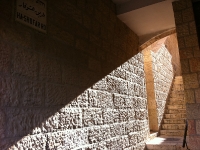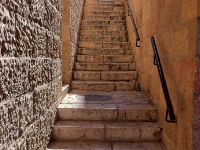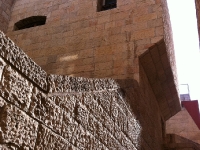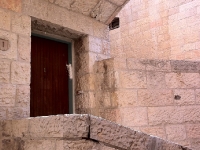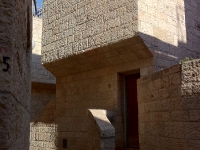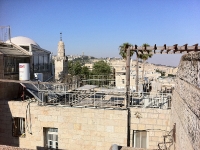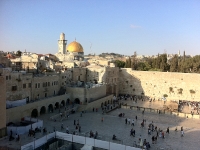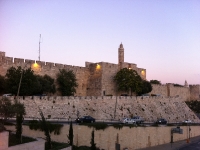MOMENTUM JERUSALEM RESIDENCY
MOMENTUM is developing a network of international artist residencies designed to serve as project spaces for the artists and galleries whom we exhibit in Berlin, and to build an interconnection and exchange across our global locations. Our first residency space is in Jerusalem inside the Old City, and will open later this year, to be followed by equally unique locations in Berlin and New York.
Jerusalem and specifically the Old City at its heart presents artists with a unique opportunity to experience and address many of the issues shaping how we live our future and how we see our history.
Cultures commingle within its walls which cannot seem to coexist outside them. The Old City in Jerusalem has maintained the peaceful coexistence of diverse cultures and religions in a geographic area where peace has for far too long been a rarity.
Comprising the Jewish, Muslim, Christian, and Armenian quarters, to this day it remains a sacred place for the western world’s major beliefs. Steeped in thousands of years of human history, this place is the historic and current epicenter for the cultural and ideological discourses which plague the Middle East and shape much of the rest of the world.
As contemporary art reflects and comments on what drives and ails our societies, the Jerusalem Residency presents artists and visitors with a truly unique perspective from the very epicenter of these discourses: a chance to live and work at the point of convergence of so many cultures and beliefs in the midst of a crucial historical moment.
PARTNERSHIP WITH MUSRARA SCHOOL OF ART
The MOMENTUM | Jerusalem Residency is designed to further the mission of MOMENTUM as a global platform for time-based art, serving as a bridge joining professional art communities across national borders, by means of Collaboration, Exchange, Education, and Exploration. Uniquely located inside the walls of the Old City in Jerusalem, Residencies are 3 – 6 months, by invitation. Artists and curators undertaking the Residency will have access to the facilities and support of the Musrara School of Art, and will in turn conduct a workshop and exhibit their work in the school’s public galleries.
Musrara, the Naggar school of Photography, Media, New Music, Animation and Phototherapy was founded in 1986 in Jerusalem’s Musrara neighbourhood. Musrara, perhaps more than any other place, symbolises the complexity of the Israeli experience: a neighbourhood situated at the divide between West and East Jerusalem, overlooking the walls of the Old City. The Naggar School works within a framework of practice based research, taking into consideration the visual biographies and unique identities that comprise society in Jerusalem. The school is strongly committed to providing a socially engaged community based art programme that is sensitive and inclusive of the multicultural communities in Jerusalem, and in Israel.
launches the MOMENTUM Jersulem Residency
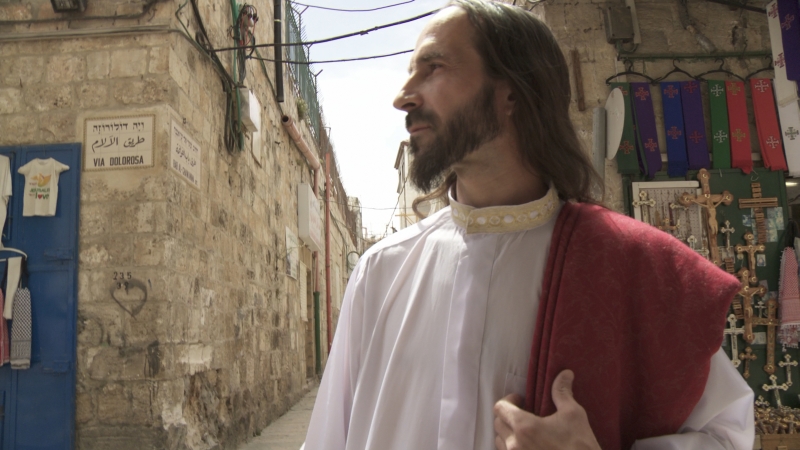
MOMENTUM is proud to open our Jerusalem residency with the participation of Katarzyna Kozyra in April and May 2013, who will be filming her new work:
Curated by Hanna Wroblewska
Director of Zacheta National Gallery
in cooperation with Atals Sztuki, Lodz
and Zak Branicka, Berlin
MOMENTUM is happy to announce that Katarzyna Kozyra will be the first artist launching the MOMENTUM Jerusalem Residency. This is the ideal project with which to open this magically unique space to artistic endeavor. Katarzyna Kozyra’s unique examination of the Jerusalem Syndrome and her whole artistic approach is the kind of work this Residency is designed to nourish and support. The MOMENTUM Jerusalem Residency is a truly magical space.
Overlooking an ancient Roman excavation in the center of the Old City, from the roof one can clearly see the Mount of Olives, and on a clear day the mountaintops of Jordan. The wailing wall is a two minute walk away, as is the Arab market. Jesus walked the streets in the place. He was entombed in a church a five minute stroll from the Residency. Perhaps its not so hard to imagine that he still walks the streets of this ancient city. Perhaps Katarzyna Kozyra will find him.
Bio
Born in Warsaw in 1963, Katarzyna Kozyra is a sculptor, photographer, author of video installations, films, performances and other artistic projects. In 1993 she graduated from the Sculpture Department at Warsaw Academy of Fine Arts (diploma “Pyramid of Animals” under prof. Grzegorz Kowalski). In 1999 Katarzyna Kozyra received Honorable mention for the Men’s Bath during the 48th International Biennale of Visual Art in Venice, “because she [KK] explores and examines the authoritarian predominance of male territory and unites the elements of performance and mise-en-scene”. Her works discuss the most fundamental issues of human existence: identity, transience, death.
She explores the area of cultural taboos related to man’s physicality and the stereotypes and forms of behaviour embedded in social life. In each of her works, Kozyra violates these taboos, risking public outcry. Her works are exhibited at the most important galleries in the world. Since 2010 she has been working on her full-length autobiographical feature film. In 2012 she established the Katarzyna Kozyra Foundation. In March 2012 Katarzyna Kozyra started in Jerusalem her latest project “Looking for Jesus”. The work is ongoing and will be developed. The premiere is scheduled in the spring, 2014 at Atlas sztuki Gallery in Łodź, Poland. She lives in Warsaw and in Berlin.
Looking for Jesus
Looking for Jesus is the latest project by Katarzyna Kozyra, a project in the making, beginning over a year ago, and continuing its creation for at least a few more months. This time, Kozyra assumes the position of a researcher, allowing us—the audience, the press, the public—to be interested in her works: into the formation process of the work, the subsequent stages of editing, tracking the film or rather video installation, from the very beginning of its creation.
The starting point for the artist is the so-called Jerusalem syndrome—an acute delusional disorder, being first clinically described in the second half of the twentieth century. Patients suffering upon visiting Jerusalem or the so-called Holy Land, identify themselves with biblical characters, and above all, mostly with the Messiah. Kozyra along with a film crew went to Jerusalem in the spring of 2012 to find those, whom at the beginning of the twenty-first century, believe they are Jesus. The result of this trip is over fifty hours of material, shot during the preparations for Easter in the Holy Land; images of Jerusalem, a stage for religious rituals, on which there are people of different backgrounds, beliefs, and creeds trying to convince the artist of their wonder and truth about being the next Messiahs as well as the colourful crowd of pilgrims and locals that are always surrounding her.
Here, a continuous performance is taking place before the artist’s eyes, in which she is not the main character or participant, but only a recipient, trying to find and record every bit of what is going on in this holy city.
The editing process, the constantly repeated review of the material and its lengthened viewing is the next stage of the contemplation of this “presentation”. At the same time, being the attempt to verify certain facts derived from the participants’ statements and to listen to their stories “anew”, which builds its own history, an alternative scenario from the beginning. It is also a moment in which the artist asks herself as well as us, the next questions: What are the mechanisms that shape our beliefs and our faith? How do we perceive reality and how do we build its view? Isn’t a critical approach and a constant verification of facts, just another kind of the intuitive desire to believe in the power of reason? – Text by Hanna Wróblewska, director of Zachęta National Gallery of Art, Warsaw.
The project was produced with the support of Ministry of Culture and National Heritage of the Republic of Poland and a private collector.


 Back to Index
Back to Index